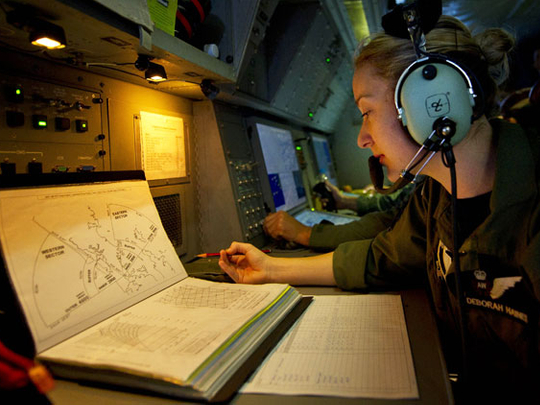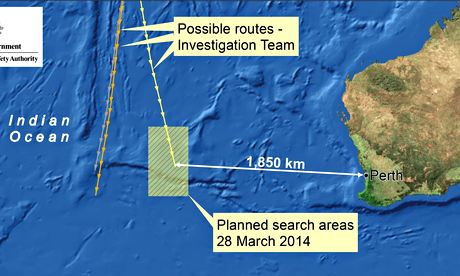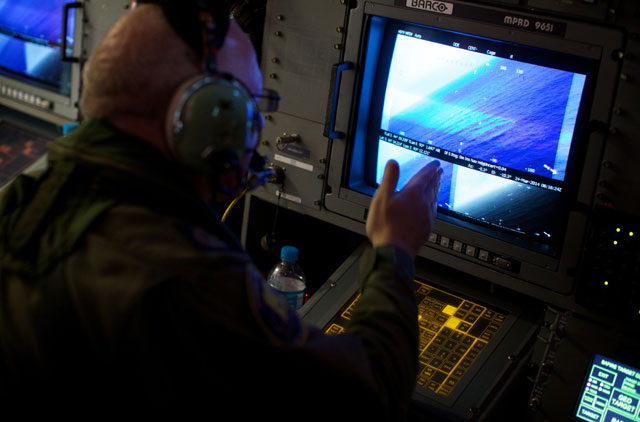
PERTH, Australia: Searchers scouring the Indian Ocean for Malaysia Airlines Flight MH370 were hoping Saturday to salvage debris for the first time which could finally confirm whether the jet plunged into the sea.
Planes attached to the multinational operation spotted "multiple objects" floating in the water on Friday after the focus of the search moved to a new area on the strength of fresh data indicating the plane was flying faster than first thought before it disappeared on March 8.
Authorities stressed that the items sighted could not be verified as coming from MH370 until they were physically examined and ships from China and Australia were steaming to the search zone in an effort to locate them.
The Australian Maritime Safety Authority (AMSA) said late Friday that one Chinese ship, the Haixun 01, was already in the area "and will be in a position to relocate the objects on Saturday".
By late Friday, the Haixun 01 had reported no major sightings except for "a few light-coloured, palm-size floating objects", official state news agency Xinhua said.
An Australian naval vessel, HMAS Success, is also expected to reach the area late Saturday and four more Chinese ships are on their way. More than two-thirds of the 239 people on board the flight were Chinese.
New Zealand Air Vice-Marshal Kevin Short said spotters from a New Zealand Orion plane saw 11 objects in the sea, most of them rectangular and ranging in size from 50-100 centimetres (20-40 inches).
"Our crew couldn't identify anything that would say it was definitely from the Malaysian aircraft," he said. "I think the main issue is that those objects will have to be picked up by a ship so they can physically examine them."
Ten aircraft from six countries - Australia, China, Japan, New Zealand, South Korea and the United States - are involved in the search, which is taking place far off Western Australia and about 1,100 kilometres (685 miles) northeast of where initial efforts were focused.
Malaysian Transport Minister Hishammuddin Hussein said the new search area, "although more focused than before, remains considerable; and the search conditions, although easier than before, remain challenging".
New search zone
The revised search sector - about the size of Norway - was "based on continuing analysis of radar data between the South China Sea and the Strait of Malacca before radar contact was lost (with MH370)", AMSA said.
"It indicated that the aircraft was travelling faster than previously estimated, resulting in increased fuel usage and reducing the possible distance the aircraft travelled south into the Indian Ocean."
The new area is closer to land, meaning planes can spend more time searching before having to return to refuel, and enjoys better weather than seas further south where the search had been concentrated.
Satellite sightings of unidentified debris by several nations in recent days in the previous zone raised hopes of finding wreckage from the Boeing 777, but nothing was retrieved as rough weather plagued the search.
Malaysia believes the plane was deliberately redirected by someone on board and flown thousands of miles southwards, but nothing else is known.
"This is a credible new lead and will be thoroughly investigated today," Australian Prime Minister Tony Abbott said of the revised search area.
Malaysian officials said the new zone was identified following an analysis of radar data by experts from Boeing who have joined an international investigation team in Kuala Lumpur.
They took MH370's estimated speed when it was briefly tracked by Malaysian military radar shortly after it diverted to the west - the last time MH370 appeared on radar.
The new search area is around 1,850 kilometres west of Perth. Australia is re-positioning its satellites to focus on it.
Black box deadline
As the search moves to the new area, the clock is ticking on the tracking signal emitted by the plane's "black box" of flight data, which lasts about 30 days.
The US Pacific Fleet has moved specialised black box locator equipment to Perth, poised to begin searching once an approximate crash site is established.
"It's critical to continue searching for debris so we can reverse-forecast the wind, current and sea state since March 8 to recreate the position where MH370 possibly went into the water," said Commander Tom Moneymaker, US 7th Fleet oceanographer.
Seeking closure, anguished families of the plane's passengers and crew are desperately awaiting solid evidence that might unlock one of aviation's greatest riddles.
Until then, many have refused to accept the Malaysian government's conclusion that the plane went down at sea.
Underscoring simmering tensions, on Friday in Beijing hundreds of Chinese family members walked out of a briefing by Malaysian officials, who were left to stare at ranks of empty chairs while a relatives' representative berated them.
Will Saturday search confirm MH370 debris?
Perth: A multinational fleet of planes and ships searching for the missing Malaysia Airlines flight MH370 has raced to a fresh search zone after a "credible new lead" suggested the plane was flying faster than first thought before it plunged into the vast Indian Ocean.
Royal Australian Air Force crew said they spotted 11 pieces of possible debris from missing jet floating in the new search area and took hundreds of photos for analysis by imagery experts.
Ten aircraft from six countries have been diverted to an area 685 miles (1,100km) north-east of where the search had been concentrated for a week, far off western Australia.
Late on Friday, the Australian Maritime Safety Authority said five aircraft had spotted "multiple objects" in the new search area.
They key would be on Saturday, when the rea is expected to be reached by ship.
New radar information
Sydney/Perth: The international air and sea taskforce hunting for the wreckage of Malaysia Airlines Flight MH370 was re-directed on Friday to an area 1,100 km north of where they have been searching for more than a week, after Australian authorities received new radar information from Malaysia.
The dramatic shift in the search area, moving it further than the distance between London and Berlin, followed analysis of radar data that showed the missing plane had travelled faster, and so would have run out of fuel quicker, than previously thought.
The new search area is larger, but closer to the Australian west coast city of Perth, allowing aircraft to spend longer on site by shortening travel times. It is also vastly more favourable in terms of the weather as it is out of the deep sea region known as the Roaring 40s for its huge seas and frequent storm-force winds.
“I’m not sure that we’ll get perfect weather out there, but it’s likely to be better more often than what we’ve seen in the past,” John Young, general manager of the emergency response division of Australian Maritime Safety Authority (AMSA), told reporters, adding the previous search site was being abandoned.
“We have moved on from those search areas to the newest credible lead,” he said.
For more than a week, ships and surveillance planes have been scouring seas 2,500 km southwest of Perth, where satellite images had suggested there could be debris from Flight MH370, which went missing on March 8 with 239 people aboard.
Ten aircraft searching on Friday were immediately re-directed to the new area of 319,000 sq km, roughly the size of Poland, around 1,850 km west of Perth. The Australian Geospatial-Intelligence Organisation was also redirecting satellites there, AMSA said.
A flotilla of Australian and Chinese ships would take longer to shift north, however, with the Australian naval ship the HMAS Success not due to arrive until Saturday morning.
The shift was based on analysis of radar data between the South China Sea and the Strait of Malacca, the Australian Transport Safety Bureau (ATSB) said.
At that time, the Boeing 777 was making a radical diversion west from its course from Kuala Lumpur to Beijing.
ATSB Chief Commissioner Martin Dolan said radar and satellite polling data had been combined with information about the likely performance of the aircraft, speed and fuel consumption in particular, to arrive at the best assessment of the area in which the aircraft was likely to have entered the water.
An international investigative team continued to analyse the data, Dolan said, which “could result in further refinement of the potential flight path of MH370”.
SHIFTING SEARCHES The latest twist underscores the perplexing and frustrating hunt for evidence in the near three-week search. It comes less than a day after the latest reports of sightings of possible wreckage, captured by Thai and Japanese satellites in roughly the same frigid expanse of sea as earlier images reported by France, Australia and China.
Satellite images had shown suspected debris, including pieces as large as 24 metres, within the original search area in the southern Indian Ocean.
Potential debris has also been seen from search aircraft, but none has been picked up or confirmed as the wreckage of Flight MH370, which disappeared from civilian radar screens less than an hour after taking off.
Officials believe someone on board may have shut off the plane’s communications systems before flying it thousands of miles off course, where it crashed into the ocean in one of the most isolated and forbidding regions on the planet.
Theories range from a hijacking to sabotage or a possible suicide by one of the pilots, but investigators have not ruled out technical problems.
David Brewster, a visiting fellow at the Strategic and Defence Studies Centre at the Australian National University, said it was surprising that the new data analysis was just coming to light.
“The Malaysians have never really had to handle a search and rescue operation of this nature before so it is maybe complicated by lack of experience,” Brewster said.
“There is no doubt they haven’t got their systems working smoothly in terms of sharing within Malaysian organisations or with neighbouring countries.” REINFORCEMENTS The US Navy said on Friday it was sending a second P8-Poseidon, its most advanced maritime surveillance aircraft, to help in the search.
“It’s critical to continue searching for debris so we can reverse-forecast the wind, current and sea state since March 8 to recreate the position where MH370 possibly went into the water,” said Commander Tom Moneymaker, a US 7th Fleet oceanographer.
The United States has also sent a device that can be towed behind a ship to pick up faint pings from the plane’s black box voice and data recorders, but time is running out.
“We’ve got to get this initial position right prior to deploying the Towed Pinger Locator since the MH370’s black box has a limited battery life and we can’t afford to lose time searching in the wrong area,” Moneymaker said.
The prolonged and so far fruitless search and investigation have taken a toll, with dozens of distraught relatives of 150 Chinese passengers clashing with police and accusing Malaysia of “delays and deception”.
Chinese insurance companies have started paying compensation to the families of passengers, some of the firms and state media said.














